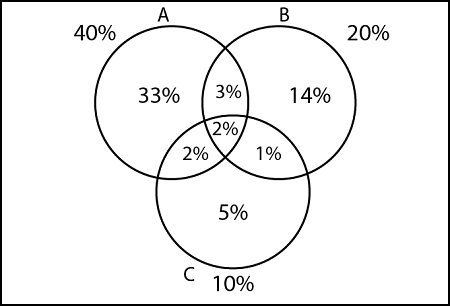Let A, B be any two finite sets. Then n (A ∪ B) = n (A) + n (B) – n (A ∩ B)
Here “include” n (A) and n (B) and we “exclude” n (A ∩ B)
Example 1:
Suppose A, B, C are finite sets. Then A ∪ B ∪ C is finite and n (A ∪ B ∪ C) = n(A) + n(B) + n(C) – n(A ∩ B) – n(A ∩ C) – n(B ∩ C) + n(A ∩ B ∩ C)
Example 2:
In a town of 10000 families it was found that 40% of families buy newspaper A, 20% family buy newspaper B, 10% family buy newspaper C, 5% family buy newspaper A and B, 3% family buy newspaper B and C and 4% family buy newspaper A and C. If 2% family buy all the newspaper. Find the number of families which buy
- Number of families which buy all three newspapers.
- Number of families which buy newspaper A only
- Number of families which buy newspaper B only
- Number of families which buy newspaper C only
- Number of families which buy None of A, B, C
- Number of families which buy exactly only one newspaper
- Number of families which buy newspaper A and B only
- Number of families which buy newspaper B and C only
- Number of families which buy newspaper C and A only
- Number of families which buy at least two newspapers
- Number of families which buy at most two newspapers
- Number of families which buy exactly two newspapers
Solution:

1. Number of families which buy all three newspapers:
- n (A ∪ B ∪ C) = n(A) + n(B) + n(C) – n(A ∩ B) – n(A ∩ C) – n(B ∩ C) + n(A ∩ B ∩ C)
- n (A ∪ B ∪ C) = 40 + 20 + 10 – 5 – 3 – 4 + 2 = 60%
2. Number of families which buy newspaper A only
- = 40 – 7 = 33%
3. Number of families which buy newspaper B only
- = 20 – 6 = 14%
4. Number of families which buy newspaper C only
- = 10 – 5 = 5%
5. Number of families which buy None of A, B, and C
n (A ∪B ∪C)c = 100 - n (A ∪ B ∪ C) n (A ∪B ∪C)c = 100 - [40 + 20 + 10 - 5- 3- 4 + 2] n (A ∪B ∪C)c = 100 - 60 = 40 %
6. Number of families which buy exactly only one newspaper
- = 33 + 14 + 5 = 52%
7. Number of families which buy newspaper A and B only
- = 3%
8. Number of families which buy newspaper B and C only
- = 1%
9. Number of families which buy newspaper C and A only
- = 2%
10. Number of families which buy at least two newspapers
- = 8%
11. Number of families which buy at most two newspapers
- = 98%
12. Number of families which buy exactly two newspapers
- = 6%
Leave a Reply